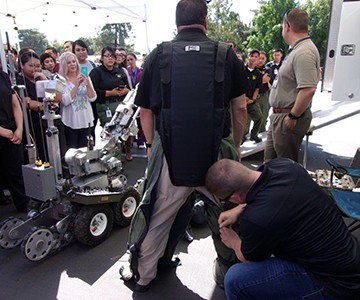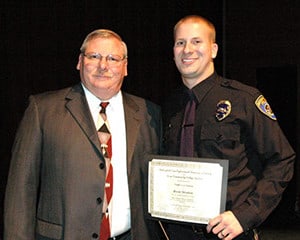Bomb Squad makes big impression on Bakersfield Criminal Justice students
 Criminal Justice: Corrections program instructor Bobby Stratton recently invited the Bakersfield Police Department’s Bomb Squad to SJVC’s campus to make a classroom and field presentation to about 50 Criminal Justice: Corrections and other medical program students.
Criminal Justice: Corrections program instructor Bobby Stratton recently invited the Bakersfield Police Department’s Bomb Squad to SJVC’s campus to make a classroom and field presentation to about 50 Criminal Justice: Corrections and other medical program students.
An hour was spent in the classroom where the bomb squad team explained the dynamics of bomb threats and their squad’s response options and protocol. “Sergeant Josh Finney gave a crime scene investigation presentation about how explosive devices are constructed, the result of detonation, and expected post-blast evidence,” says Larry Hidalgo, Criminal Justice: Corrections Program Director.
Outside, the bomb squad spent a couple of hours demonstrating their robot, bomb suit and control center located inside their 42-foot truck, which is more like a motor home. It is a very high-tech unit that can fit 4-6 people using computers and scanning equipment, and houses shovels, axes and other tools.
The communication among the three bomb squad entities – robot, bomb suit wearer and the truck’s command center – can take several hours before the suspected explosive device is finally infiltrated and disabled.
“It was interesting to know what they do and how much patience they have,” says Jomira Ibarra, Criminal Justice: Corrections student. “There are a whole bunch of areas in law enforcement that now have this.”
“A lot of information was provided about the history of homemade bombs, what type of people use them out there and what to be on the lookout for,” says Hidalgo. “There is a wide range of explosives, from grenade size to large bombs and, with the internet, it’s much easier to get materials.” He stresses that the business world is helpful in limiting some of the materials and some areas require a license to purchase them.
The hit of the day had to be the highly functioning robot. At about 4-feet tall and rolling on a track like a military tank, the $350,000 robot is operated by a technician at the control board in the truck.
A few students were invited to maneuver the robot from the command center.
“They allowed me to move the robot, make it go forward and bring it back,” says Ismael Alcala, Criminal Justice: Corrections student. “The arm can go in just about any direction and reach out pretty far.”
Ismael had no problem directing the robot to squeeze a bottle of water. “Growing up you play video games, so you could relate to the controls pretty easily,” he says.
The bomb suit is another fascinating piece of equipment. The 120-pound, whole-body suit includes boots, helmet with glass face mask and communication headset. Jomira got to try it on. “It was just really heavy,” she says. “It’s interesting how these guys can move around with this heavy suit on like they’re having fun with it; but, it’s not so easy.”
Ismael was fascinated by information given about the wave of a bomb’s blast. “They taught us that the black wave of an explosion behaves like water,” he says. “People believe that they can run and hide behind a building, but the energy of the wave will wrap around objects, and you can still get hit and have serious damage to the body.”
Medical program students also benefitted from the Bomb Squad’s presentation, as their material related to first responders at an explosion site and potential victims. Some injuries are very specific to explosions.
Many students are giving the Police Department’s Bomb Squad serious consideration as a career, once they graduate. “A lot of the girls (in the Criminal Justice: Corrections program) thought about the fact that it’s really shocking that there were no girls in the Bomb Squad,” says Jomira. “It would be pretty cool to be one of the first girls to join.”
The presentation provided a close-up look at an important facet of the Police Department. “It reinforced me wanting to further my career in criminal justice,” says Ismael. “It’s good to learn the truth of what really happens out there in the world.”
An important takeaway from the Bomb Squad’s presentation that day was one of caution: “Always know your surroundings; if anything looks suspicious – a stand-alone box or bag – that’s what you want to be on the lookout for,” says Larry Hidalgo.
Learn More About A Career In Criminal Justice: Corrections
Criminal Justice: Corrections can open doors to work in private, state, federal prisons or local jails as well as in private security in California. Learn how to join this exciting career and why you should pursue a correctional officer degree.
You might also like
More stories about
Request Information
All fields using an asterik (*) are required.


